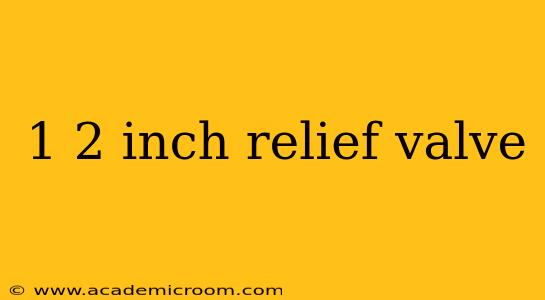A 1-1/2 inch relief valve is a crucial safety device used in various industrial and commercial applications to protect equipment and processes from overpressure. This comprehensive guide will explore the functionality, applications, selection criteria, and maintenance of these essential components. We'll also address some frequently asked questions surrounding their use.
What is a 1 1/2 Inch Relief Valve Used For?
A 1-1/2 inch relief valve, like other pressure relief valves, is designed to automatically release excess pressure from a system when it exceeds a predetermined setpoint. This prevents potentially catastrophic failures due to overpressurization. Its 1-1/2 inch size refers to the nominal pipe size of the valve's connection, indicating its flow capacity. The specific applications vary widely depending on the pressure rating and design of the valve, but common uses include:
- Process Piping: Protecting pipelines and process equipment in chemical, petrochemical, and power generation industries.
- Hydraulic Systems: Safeguarding hydraulic presses, lifts, and other machinery from excessive pressure buildup.
- Pneumatic Systems: Preventing overpressure in compressed air systems.
- Steam Systems: Relieving excess pressure in boilers, turbines, and other steam-powered equipment.
What are the Different Types of 1 1/2 Inch Relief Valves?
Several types of 1-1/2 inch relief valves exist, each suited for specific applications and pressure ranges. These include:
- Spring-loaded relief valves: The most common type, relying on a spring to maintain the set pressure. These are relatively simple, reliable, and cost-effective.
- Pilot-operated relief valves: These valves use a pilot signal to control the opening and closing of the main valve, allowing for more precise pressure control and often higher flow capacities.
- Safety relief valves (SRV): Designed to protect against overpressure and potential hazards, often incorporating features like a rupture disc as a secondary safety mechanism. These are frequently subject to stricter regulations and testing requirements.
How Do I Choose the Right 1 1/2 Inch Relief Valve?
Selecting the appropriate 1-1/2 inch relief valve necessitates careful consideration of several factors:
- Set Pressure: The pressure at which the valve opens. This needs to be carefully calculated based on the system's operating pressure and potential overpressure scenarios.
- Flow Capacity: The volume of fluid the valve can discharge at its set pressure. This is crucial to ensure adequate protection for the system.
- Pressure Rating: The maximum pressure the valve can withstand without failure.
- Material Compatibility: The valve's materials must be compatible with the fluid being handled to avoid corrosion or other issues.
- Connection Type: The valve's connection (e.g., threaded, flanged) must match the system's piping.
How Often Should a 1 1/2 Inch Relief Valve Be Maintained?
Regular maintenance is critical for ensuring the reliability and safety of a 1-1/2 inch relief valve. The frequency of maintenance depends on factors such as the operating conditions, the fluid being handled, and relevant safety regulations. However, a minimum annual inspection and testing are generally recommended. This may include:
- Visual inspection: Checking for leaks, corrosion, and damage.
- Functional testing: Verifying the valve's opening and closing pressure.
- Calibration: Adjusting the set pressure as needed.
What are the Safety Precautions When Working with 1 1/2 Inch Relief Valves?
Working with pressure relief valves, including 1-1/2 inch valves, requires adherence to strict safety procedures. Always ensure:
- Proper lockout/tagout procedures: Prevent accidental activation during maintenance or repair.
- Appropriate personal protective equipment (PPE): Use safety glasses, gloves, and other PPE to protect against potential hazards.
- Pressure relief valve testing by qualified personnel: Only trained and certified individuals should perform maintenance or testing of pressure relief valves.
What are the Common Causes of 1 1/2 Inch Relief Valve Failure?
Several factors can lead to 1-1/2 inch relief valve failure, including:
- Corrosion: Exposure to corrosive fluids can weaken the valve's components.
- Erosion: High-velocity fluid flow can erode the valve's internal parts.
- Fouling: Build-up of debris can hinder the valve's operation.
- Improper installation: Incorrect installation can compromise the valve's functionality.
- Lack of maintenance: Neglecting regular maintenance can lead to premature failure.
This comprehensive guide provides a foundation for understanding 1-1/2 inch relief valves. Always consult relevant industry standards, safety regulations, and the manufacturer's instructions for specific applications and maintenance procedures. Remember, the safety and reliability of your system depend on the correct selection, installation, and maintenance of these crucial components.
